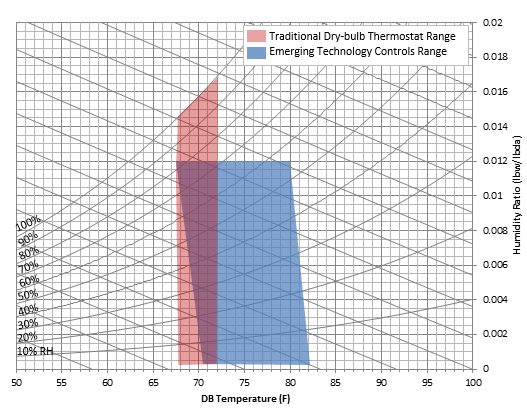 Project Title
Project Title
HVAC with Dynamic Energy and Demand Optimization
Project Number ET14SDG7011 Organization SDG&E End-use HVAC Sector Commercial, Public Project Year(s) 2014 - 2015The emerging technology (ET) presented in this report is an HVAC management system with dynamic energy and demand optimization designed for commercial rooftop units (RTUs) and split system applications. The ET replaces a traditional thermostat with multiple sensors that measure dry-bulb temperature and relative humidity in a zone. The information from the sensors is sent to an on-site controller, which relays the information to a cloud server for storage, analysis, and reporting. The on-site system then dynamically evaluates zone conditions using the sensor data, weather data (as a proxy for radiant heat), schedule information, as well as specific zone-by-zone properties such as air flow rates that are stored in the system’s database. The controller then activates fans, compressors, and furnaces as applicable to maintain a "comfort" setpoint. The control mechanism differs from traditional thermostats, where fans and compressors are activated based solely on a specific dry-bulb temperature versus the whole comfort temperature relative humidity range.
The collected data were also used to compare the thermal zone conditions before and after the installation of ET using the ASHRAE 55 thermal comfort zone as a guideline. The results revealed that the ET was able to improve the zone condition within the thermal comfort zone limits, therefore improving the occupants comfort.
In this report, the energy savings associated with the proposed ET were evaluated by using the field test results obtained from two test sites. The technology yielded savings due to several factors:
Reducing the run time of RTUs with scheduling and soft start strategies.
Reducing the run time of the compressor by applying a "comfort" setpoint and therefore increasing the fan-only operating range.
Analytical fault detection and diagnostics (FDD) to alert building operators of non-catastrophic conditions that might waste energy.
The data analysis of the first field test showed a 29% reduction in energy used across five heat pumps and the second field test showed an overall 38% reduction in energy used across nine AC units due mainly from advanced scheduling. The calculations also found that the ET achieved 8% savings during occupied times at the second site, which could potential qualify for utility incentive.
Finally, the ET was tested for its demand response and permanent demand reduction capabilities. The results showed that the ET was able to reduce the combined peak power of a facility by 30% by coordinating the operations of multiple units during a DR event.
